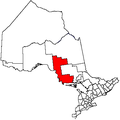Goulais Bay 15C | |
|---|---|
Former Indian reserve | |
| Goulais Bay Indian Reserve No. 15C | |
| Coordinates: 46°31′N84°35′W / 46.517°N 84.583°W | |
| Country | |
| Province | |
| District | Algoma |
| First Nation | Batchewana |
| Area | |
| • Land | 0.02 km2 (0.008 sq mi) |
Goulais Bay 15C was a First Nation reserve within Prince Township, Ontario. This 5-acre tract of land was given to the Batchewana First Nation after Whitefish Island was expropriated from them in 1902. The land was sold by the band in 1956 for $3,600, and it ceased to be a reserve. [1]

